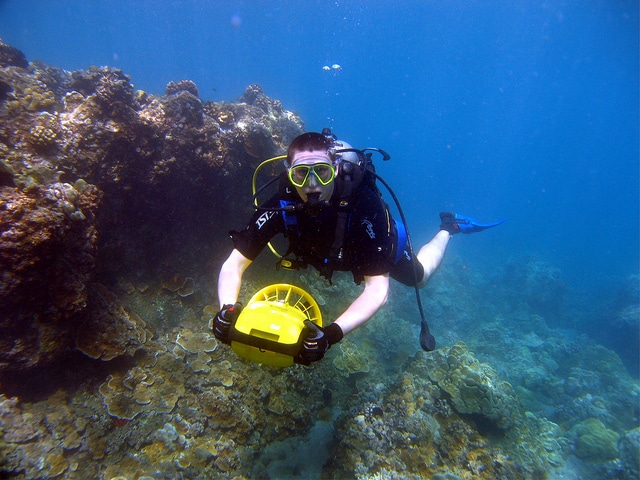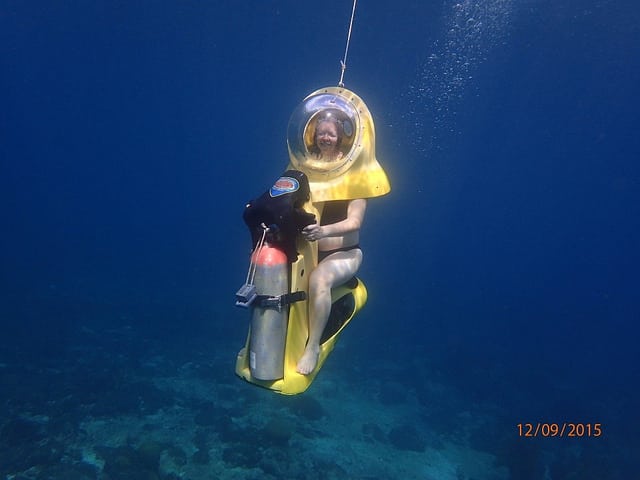Diver propulsion vehicles (DPV) sometimes also called sea scooters are the underwater equivalent to the jet ski. They can be used in a utility means or just as a blast of fun. Their use as a utility device dates back to the early days of scuba diving. Originally developed to allow frogman to travel long distance underwater or to transport bulky items, they quickly became popular for civilian divers. Television programs of the 60s such as Sea Hunt (1958-1961) and movies often featured them. James Bond used them in Thunderball as well as in later movies. These programs and movies connected scuba and the DPV together in many peoples minds.
The benefits of using diver propulsion vehicles are summarized in that they enable the diver to cover greater distances while allowing the diver to use less energy. Using less energy can translate into slower air consumption and longer bottom times. Many divers also report that using Diver propulsion vehicles allows them to concentrate more on their breathing. A diver propulsion vehicle could get a diver to an off shore dive site that might be out of range without one. Many shore divers use them as a trip from shore to an off shore dive site with little air consumption allowing a longer dive. Even from a boat, a scooter can help a diver see more. Many wrecks are too large to see with a single tank. The combination of speed and less air consumption may allow a diver with a scooter to see more, possibly the entire wreck or dive site.

There are a few different styles of diver propulsion vehicles with no formal definition of the names. The most common type is the tow style. The device looks like a small torpedo with a protected propeller and the diver is pulled behind it. There are hand controls and grips on both sides of the device. The diver holds onto the grips and use them to control the speed of the motor of the device. Depending on the model a diver may use his arms to point the device in the direction they want to go or use diving planes that are a part of some vehicles. You may sometimes see these types of devices called a diver tug. A variation of the tow style has the diver connected to the scooter with a line from the BCD or a separate back plate.
The second main type is the sit-on style. These remind me of being a child and going sledding in the winter. Depending on the model you could sit up on them straddling them or lay face down and zip along. A few of the high end models can be used in either style.
What to Look for in a Dive Scooter
Dive scooters / DPV come in a wide range of features and prices. Prices can range from a few hundreds of dollars to many thousands. Some units are more meant for snorkeling and very shallow diving. While other units, have features for deep technical dives and caving. There are many items to consider while looking to buy an underwater scooter. You should consider how you will use it and then check each items features. The type of material and how well it should stand up to your style of use should be a prime consideration. The maximum depth should also be one of the key points. If you plan on diving to 30 meters, then one rated for only 5 meters will not work. The type of battery and how long they will last should be a consideration. A scooter with a 30 minute usage time might not be the right one for you if you are going to use them to get you to an off shore dive site as an example. Also consider how a battery is recharged and how long will it take. The weight above water may be an issue for some divers. Like any diving device, there will be certain maintenance items you will need to do, check out what is required so you are not surprised later.
Before using a diver propulsion vehicle, you need to become familiar with its operations. Most of the accreditation agencies have certification programs for scooters. However, certification is not required so taking a short orientation class may be all that you need.
Dangers of Diver Propulsion Vehicles
There are a few dangers that divers may not be aware of or they might just slipped their minds. Possibly the most dangerous, is the speed that divers can change depths. Doing an underwater “barrel roll” can seem like a fun challenge, however, the rapid ascent could lead to a decompression illness. A rapid rise could cause the onset of Decompression Sickness (DCS) or an Arterial Gas Embolism (AGE). The rapid change in pressure could lead to equalization problems even a broken ear drum. Just pointing the DPV straight up or down could create the same impact.
Another risk is traveling too far away from your dive end point and losing power. You can cover a great distance underwater with one of these scooters. However, where will you be and how will you get back if your ride runs out of power. If you were on a shore dive and traveled for a half hour underwater directly away from the shore, you could find yourself 2 miles of more off shore. How would you get back if the motor shut down? When you plan a dive where you will be using a scooter, this question should be kept in mind. One often used rule of thumb is the rule of thirds. Use 1/3 of your DPV power level moving away from the start point, 1/3 to return. The remainder is a safety level. Just like using the rules for wreck diving, once you are back to a point that you can easily return to your tarting point without the scooter then it now problem using some the reserve.

Wet Subs and Semi-wet Subs
Two terms that you will also see with this topic are wet subs and semi-wet subs. A wet sub is a device that a diver gets into and travels underwater. The diver uses a scuba tank for breathing. Some models will have a cockpit and an independent air supply. The operating conditions of these wet subs are tied to the diving rules.
A semi-wet sub leaves the occupant partially in the water. They have a bubble that is filled with air. Generally the occupants chest and head are out of the water and they breathe normally in the air pocket. They are able to talk with others in the semi-wet sub. An air source located within the sub adds air to the pocket at a constant rate. Excess air is allowed to escape the bubble. This insures there is no build up of carbon monoxide. Recently a variation of a semi-wet sub has entered the tourism industry. You may see either a BOSS (Breathing Observation Submersible Scooter) or BOB (Breathing Observation Bubble) being advertised at resorts. These devices are marketed towards non-divers who want to explore underwater. A guest enters the device sitting down like on a motor scooter. It is then placed in the water. The head and shoulders are within the bubble portion that is filled with air. Accompanied by a diver, the scooters can explore a reef or other shallow dive site. Many times these devices are tethered to the surface restricting the range they can travel from the starting point.
A diver who has not tried a diver propulsion vehicle yet should really give it a try at least once, it might up open a whole new level of diving fun for you. Or maybe you want to challenge Wolfgang Kulow’s new distance record, I know I won’t.

